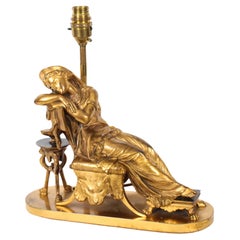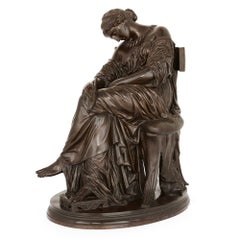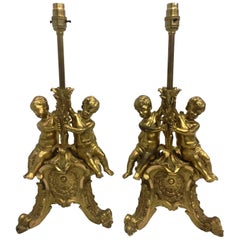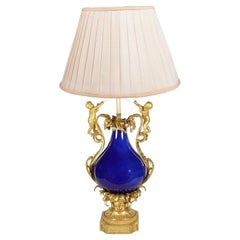Pierre Jules Cavelier
2
to
2
2
2
2
2
2
2
1
2
2
1
5,224
4,014
2,455
2,235
Creator: Pierre-Jules Cavelier
Antique French Ormolu Table Lamp Manner of Pierre-Jules Cavelier 19th Century
By Pierre-Jules Cavelier
Located in London, GB
This is a fine antique ormolu Louis XVI Revival table lamp in the manner of Pierre-Jules Cavelier (French 1814-1894), circa 1890 in date.
The ormolu sculpture is modelled as a class...
Category
1890s French Antique Pierre Jules Cavelier
Materials
Bronze, Ormolu
Classical Style Bronze Sculpture of Penelope by Cavelier and Barbedienne
By Ferdinand Barbedienne, Pierre-Jules Cavelier
Located in London, GB
This large patinated bronze antique sculpture depicts the Classical figure Penelope, the wife of Odysseus (Roman name Ulysses) who appears in ...
Category
Late 19th Century French Neoclassical Revival Antique Pierre Jules Cavelier
Materials
Bronze
Related Items
Pair of 19th Century Gilded Ormolu Lamps
Located in Brighton, Sussex
A good quality pair of French 19th century gilded ormolu lamps, each having two putti seated on a scrolling foliate base.
Category
Late 19th Century French Louis XVI Antique Pierre Jules Cavelier
Materials
Ormolu
Sevres style ormolu lamp, 19th Century.
By Cristalleries De Sevres
Located in Brighton, Sussex
A very impressive late 19th century French Sevres style porcelain and gilded ormolu vase / lamp. Having classical putti mounted on each scrolling foliate handle, raised on Palm tree ...
Category
Late 19th Century French Antique Pierre Jules Cavelier
Materials
Ormolu
French 19th Century Renaissance St. Ormolu Lamp
Located in West Palm Beach, FL
A beautiful French 19th century Renaissance st. ormolu lamp. The lamp is raised by a lovely circular base with a fine wrap around foliate band below the pierced dome shape support displaying scrolled...
Category
19th Century French Renaissance Antique Pierre Jules Cavelier
Materials
Ormolu
F. Barbedienne Large Bronze Sculpture of Euterpe
By F. Barbedienne Foundry
Located in Wormelow, Herefordshire
A bronze sculpture of Euterpe attributed to French metalworker Ferdinand Barbedienne (1810-1892). Embellished to the reverse with the official stamp of the Collas et Barbedienne foun...
Category
Mid-19th Century French Neoclassical Antique Pierre Jules Cavelier
Materials
Bronze
Large Grand Tour Sculpture Bronze Greco-Roman Uffizi Wrestlers Barbedienne
By Ferdinand Barbedienne
Located in Rochester, NY
Grand Tour circa 1860s bronze of the Wrestlers. Rich fine dark brown patina. Marked "F. Barbedienne Fondeur." The Wrestlers also known as The Two Wrestlers, The Uffizi Wrestlers or The Pancrastinae...
Category
19th Century Italian Grand Tour Antique Pierre Jules Cavelier
Materials
Bronze
H 18.5 in W 22.5 in D 14 in
Ferdinand Barbedienne " Diana" Sculpture, 19th Century
By Ferdinand Barbedienne
Located in Madrid, ES
"Diane de Gabies"
French sculpture, late 19th century.
Patinated bronze with "Ferdinand Barbedienne" foundry marks.
Height: 51 cm.
Very good condition.
Category
19th Century French Baroque Antique Pierre Jules Cavelier
Materials
Bronze
Jean-Baptiste Auguste Clesinger, French Bronze Bust of Jesus Christ, Barbedienne
By Ferdinand Barbedienne
Located in New York, NY
An exceptional French patinated realistic miniature bronze bust of Jesus Christ, 1858
Signed: J CLESINGER. 1858 and F. BARBEDIENNE FONDEUR, wi...
Category
19th Century French Antique Pierre Jules Cavelier
Materials
Bronze
H 6.5 in W 3.5 in D 2.5 in
Jean-Baptiste Auguste Clesinger, French Bronze Bust of Jesus Christ, Barbedienne
By Ferdinand Barbedienne
Located in New York, NY
An exceptional French patinated realistic miniature bronze bust of Jesus Christ, 1858
Signed: J CLESINGER. 1858 and F. BARBEDIENNE FONDEUR, wi...
Category
19th Century French Antique Pierre Jules Cavelier
Materials
Bronze
H 7.5 in W 5 in D 3 in
Jean-Baptiste Auguste Clesinger, French Bronze Bust of Jesus Christ, Barbedienne
By Ferdinand Barbedienne
Located in New York, NY
An exceptional French patinated realistic bronze bust of Jesus Christ, circa 1858
Signed: J CLESINGER. & F. BARBEDIENNE FONDEUR, with the Reduction Me...
Category
19th Century French Antique Pierre Jules Cavelier
Materials
Bronze
H 12.5 in W 9 in D 4.5 in
Ferdinand Barbedienne Bronze Sculpture of Diana of Gabii
By Ferdinand Barbedienne
Located in Kastrup, DK
Ferdinand Barbedienne 1810-1892.
A brown patinated bronze statuette after the antique of "Diana of Gabii"
Signed F. Barbedienne. Barbedienne foundry m...
Category
19th Century French Neoclassical Revival Antique Pierre Jules Cavelier
Materials
Bronze
‘Gloria Victis’, A Patinated Bronze Figural Group by Mercié, Cast by Barbedienne
By Ferdinand Barbedienne
Located in Brighton, West Sussex
A Patinated Bronze Figural Group of ‘Gloria Victis’ (‘Glory to the Vanquished’), Cast by Ferdinand Barbedienne from the Model by Marius-Jean-Antonin Mercié (French, 1845-1916).
‘Gloria Victis’ (‘Glory to the Vanquished’).
Bronze, gilt and dark brown patina.
Signed 'A. Mercié', with foundry inscription 'F. BARBEDIENNE, Fondeur. Paris.' and A. Collas reduction cachet. The integral base titled 'GLORIA VICTIS'.
This cast is part of a limited edition by the Barbedienne Foundry.
France. Circa 1880.
‘Gloria Victis’ is one of the most recognisable and important works of sculpture of the nineteenth century and a definitive image of France’s historic national identity. The figure of glory, winged and wearing armour, carries a dying young warrior heavenwards towards fame and immortality. The compositional daring of the group must be admired for balancing two figures on the minimal support of one foot, wings spread in the moment before taking flight.
Mercié was a student at the French Academy of Rome when the Prussians invaded France in 1870. Shortly after the war had begun, he executed a group depicting the figure of Fame supporting a victorious soldier. When news reached Mercié in Rome that the French had surrendered, he decided to alter his group, replacing the victorious soldier with a defeated casualty, thus transforming an allegory of ‘Glory to the Victors’ into one of ‘Glory to the Vanquished’. Completed in 1872, a year after the defeat of French soldiers against the Prussian army, the statue personifies a defeated but heroic France. The title is also a reversal of the famous formula, ‘Vae Victis’ (Death to the Vanquished), which the Gallic general Brennus exclaimed upon defeating the Romans in 390 BC. The figure of the fallen soldier was thought to represent Henri Regnault, a fellow sculptor of Mercié who was killed on the last day of fighting.
Measuring 317 cm. high the original group of ‘Gloria Victis’ was unveiled in plaster at the Salon of 1872. It was bought by the City of Paris for the sum of twelve thousand francs and then cast in bronze by Victor Thiébaut for eight thousand five hundred francs. The bronze was exhibited at the Salon in 1875 and first placed in Montholon Square in the 8th arrondissement. In 1884 it was transferred to the courtyard of the Hôtel de Ville and in 1930, it entered the collection of the Musée du Petit Palais, where it can be seen to this day.
The Thiébaut Frères foundry also cast Gloria Victis bronzes for the cities of Niort (requested 1881) Bordeaux (requested 1883), Châlons-sur-Marne (today, Châlons-en-Champagne; requested 1890), and Cholet (requested 1901). In 1905, the Danish brewer and art collector Carl Jacobsen was permitted to have an exact cast made of the original sculpture in Paris, on condition that the base was made 2 cm lower and bore the inscription “Original tilhører Paris By” (The original belongs to the City of Paris). It too was cast by the Thiébaut Frères foundry. Gloria Victis was one of Jacobsen’s most important and his last acquisition. Today it has been returned to its original position in the Winter Garden at Glyptoteket, Copenhagen, Denmark.
The full-size plaster was shown again at the Paris Expositon universelle of 1878 alongside a bronze reduction by Barbedienne. By this time Antonin Mercié had entered into a commercial edition contract with the Ferdinand Babedienne foundry to produce bronze reductions of Gloria Victis, his most famous work. Gloria Victis is first recorded to have been produced in three sizes and by 1886 Barbedienne’s ‘Catalogue des Bronzes D’Art’ lists six sizes measuring 3/5, 9/20, 7/20, 3/10, 6/25 and 2/10, of the original. These reductions were produced by an invention of Barbedienne’s business partner Achille Collas. The Collas reducing machine was a type of complex mechanical pantograph lathe that enabled sculpture to be mathematically measured and transcribed to scale, in the round, thus making a reduced size plaster from which a bronze could be cast.
Mercié's modern sculpture had become an instant classic, even receiving an entry in the Nouveau Larousse Illustré. The success of the group undoubtedly lay in the fact that it was admired not just on an aesthetic level, but also on a patriotic level, particularly in its commemoration of heroism in defeat. Immediately ‘Gloria Victis’ was recognised as a national artwork, capable of arousing patriotism and casts were ordered from Barbedienne as local memorials commemorating the war’s dead for cities across France. ‘Gloria Victis’ was considered so much a part of France’s national identity that for the 1900 Paris Exhibition, Ferdinand Barbedienne’s nephew Gustave Leblanc, loaned a bronze example to feature as part of l’Exposition centennale de l’art français.
Literature:
For an interesting account of the process of creating a reduction in bronze of the Gloria Victis by Barbedienne and illustrations of the casting and finishing of the bronze see:
'Ferdinand Barbedienne': Theodore Child; Harper's new monthly magazine, Volume 73, Issue 436, September 1886.
‘Contemporary French Sculptors’: The Century, Volume 33, Issue 3, Jan 1887.
‘Modern French Sculpture’: Harper's new monthly magazine, Volume 76, Issue 452,
January 1888.
S, Lami, ‘Dictionnaire des sculpteurs de l'Ecole française au dix-neuvième siècle’, Tome III. G.-M., Paris, 1914, p. 432.
Peter Fusco and H.W. Janson, The Romantics to Rodin: French Nineteenth Century Sculpture from North...
Category
19th Century French Antique Pierre Jules Cavelier
Materials
Bronze
H 41.74 in W 16.54 in D 14.18 in
French 19th Century Patinated Bronze Statue Signed P. Dubois And F. Barbedienne
By Ferdinand Barbedienne
Located in West Palm Beach, FL
An exceptional French 19th century patinated bronze statue signed P. Dubois and F. Barbedienne. The statue entitled Le Courage Militaire, is raise...
Category
19th Century French Antique Pierre Jules Cavelier
Materials
Bronze
H 34 in W 14 in D 16 in
Previously Available Items
"Penelope Sleeping" Bronze Sculpture by Pierre Jules Cavelier"
By Pierre-Jules Cavelier
Located in Shippensburg, PA
This is a precious little antique bronze sculpture by Pierre Jules Cavelier, originally exhibited at Salon in 1842 as Femme Grecque Edormie in plaster, was later exhibited in 1849 as...
Category
19th Century French Romantic Antique Pierre Jules Cavelier
Materials
Bronze
Bronze Sculpture of Penelope, French, 19th Century
By F. Barbedienne Foundry, Pierre-Jules Cavelier
Located in London, GB
French, 19th century bronze sculpture of Penelope waiting for Odysseus, probably cast by the Barbedienne foundry to a design by Pierre-Jules Cavalier, stamped to the rear 'J.Cavelier...
Category
Mid-19th Century French Classical Greek Antique Pierre Jules Cavelier
Materials
Bronze
19th Century Silvered French Bronze Sculpture "Penelope" by Pierre Cavelier
By F. Barbedienne Foundry, Pierre-Jules Cavelier
Located in Shippensburg, PA
This is a precious little antique bronze sculpture by Pierre Jules Cavelier, originally exhibited at Salon in 1842 as Femme Grecque Edormie in plaster, was later exhibited in 1849 as a marble sculpture under the title of Penelope. It was cast almost exclusively by the foundry of Ferdinand Barbedienne and is the only Cavelier sculpture to appear in their 1886 catalog in five reductions after the original. His works are quite scarce, only two sculptures being catalogued in Berman's extensive reference work (vol. III). The sculpture is a highly detailed sand cast example, expertly tooled and finished with a silver patina set against a rubbed bronze accent in the base and chair. The side of the seat is impressed with a seal typical of Cavelier, noting it as number 258.
Pierre Jules Cavelier was born in August of 1814 and studied under both P. Delaroche and David D'Angers at the Ecole des Beaux-Arts after his entry in 1831. In 1836 he won second prize at the Prix de Rome for his model of Death of Socrates and with his sculpture of Diomedes Removing the Image of the Goddes Pallas Athene...
Category
1880s French Romantic Antique Pierre Jules Cavelier
Materials
Marble, Bronze, Steel
H 13.5 in W 11 in D 8.5 in
Pierre Jules Cavelier Bronze Sculpture of Penelope by F. Barbedienne
By F. Barbedienne Foundry, Pierre-Jules Cavelier
Located in Shippensburg, PA
PIERRE JULES CAVELIER (FRENCH, 1814-94) BRONZE SCULPTURE OF A SLEEPING WOMAN
"Penelope", cast by F. Barbedienne Fondeurs, sealed verso "729 J Cavelier" with A. Collas reduction seal
Item # 503DIP07
This is a precious little antique bronze sculpture by Pierre Jules Cavelier, originally exhibited at Salon in 1842 as Femme Grecque Edormie in plaster, was later exhibited in 1849 as a marble sculpture under the title of Penelope. It was cast almost exclusively by the foundry of Ferdinand Barbedienne and is the only Cavelier sculpture to appear in their 1886 catalog in five reductions after the original. This cast is La reduction no. 4, originally offered at 200 francs with a height of 25 cm. His works are quite scarce, only two sculptures being catalogued in Berman's extensive reference work (vol. III). The sculpture is a highly detailed sand cast example, expertly tooled and finished with a brown patina. The details throughout are finely chiseled, the back of the seat being impressed with a seal typical of Cavelier. Beneath the sculpture, across the bronze stretcher, are ink inscriptions of "48531" with another faded and somewhat illegible inscription; beneath the bar is an impression of "C.77E75". For the serious collector of Romantic period bronze sculptures, this is a finely detailed and well preserved acquisition.
Pierre Jules Cavelier was born in August of 1814 and studied under both P. Delaroche and David D'Angers at the Ecole des Beaux-Arts after his entry in 1831. In 1836 he won second prize at the Prix de Rome for his model of Death of Socrates and with his sculpture of Diomedes Removing the Image of the Goddes Pallas Athene...
Category
Late 19th Century French Romantic Antique Pierre Jules Cavelier
Materials
Bronze
Small Barbedienne French Bronze Sculpture of Penelope by Pierre Cavelier
By F. Barbedienne Foundry, Pierre-Jules Cavelier
Located in Shippensburg, PA
PIERRE JULES CAVELIER (FRENCH, 1814-94) ANTIQUE BRONZE SCULPTURE "PENELOPE", CAST BY F. BARBEDIENNE
Impressed "J. Cavelier 887" w/ the A. Collas reduction seal and inscription in the base of "432 F. Barbedienne Fondeurs", c. 1860-80
This is a precious little work by Pierre Jules Cavelier, originally exhibited at Salon in 1842 as Femme Grecque Edormie in plaster, later as marble in 1849 under the title of Penelope. It was cast almost exclusively by the foundry of Ferdinand Barbedienne and is the only Cavelier sculpture to appear in their 1886 catalog in five reductions after the original. This cast is La reduction no. 5, originally offered at 125 francs with a height of 16 cm. His works are very scarce, only two sculptures being catalogued in Berman's extensive reference work (vol. III). The present example is particularly delightful for it's stunning patina, the deep red with hints of black and browns, specks of black and traces of gold. It is absolutely stunning. Moreover, particularly surprising is the level of detail in a work of such diminutive proportions - a very high level of skill is demanded to cast a work this small with this level of utter perfection, the tooling of the clothing and stool executed with the precision of a jeweler. It is exquisitely preserved with only the most minor of patina wear.
Pierre Jules Cavelier was born in August of 1814 and studied under both P. Delaroche and David D'Angers at the Ecole des Beaux-Arts after his entry in 1831. In 1836 he won second prize at the Prix de Rome for his model of Death of Socrates and with his sculpture of Diomedes Removing the Image of the Goddes Pallas...
Category
19th Century French Antique Pierre Jules Cavelier
Materials
Bronze
Pierre-jules Cavelier furniture for sale on 1stDibs.
Pierre-Jules Cavelier furniture are available for sale on 1stDibs. These distinctive items are frequently made of metal and are designed with extraordinary care. There are many options to choose from in our collection of Pierre-Jules Cavelier furniture, although gold editions of this piece are particularly popular. If you’re looking for additional options, many customers also consider furniture by Alfred Boucher, Antonio Canova, and Thiebaut Freres. Prices for Pierre-Jules Cavelier furniture can differ depending upon size, time period and other attributes — on 1stDibs, these items begin at $68,131 and can go as high as $68,131, while a piece like these, on average, fetch $68,131.





